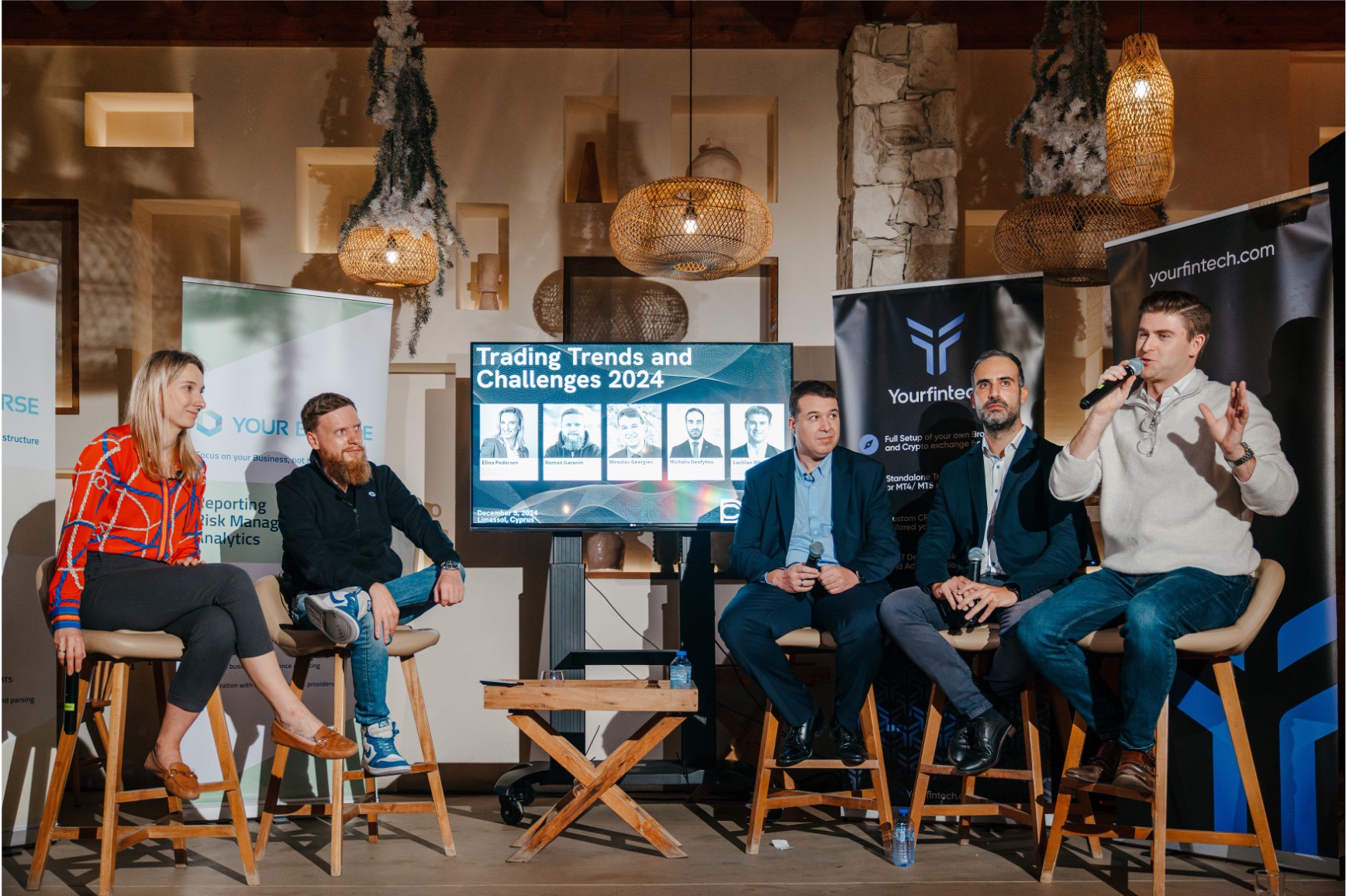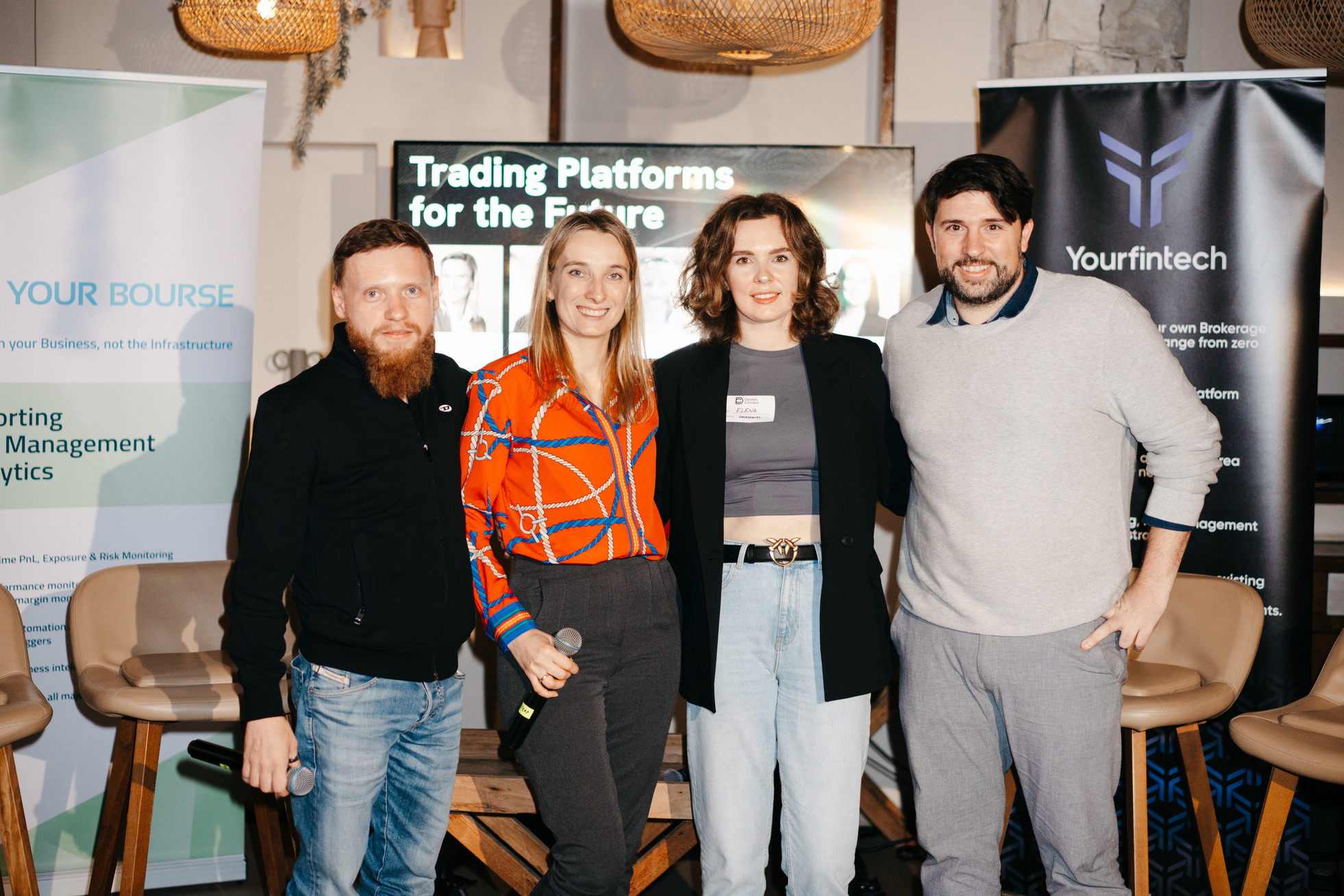Dealers Connect 4.0: Trading Platforms for the Future & Trading Trends and Challenges 2024 Panel Discussions Recap
On December 5th 2024, Dealers Connect 4.0 brought together industry leaders at the beautiful restaurant Noa in Limassol. The event was a blast - with lots of great food, tasty drinks and meaningful conversation like the panel discussions we put together, hosted by Elina Pedersen (Co-Founder and CRO of Your Bourse) and Roman Garanin (Founder and CEO of Yourfintech).
Trading Trends and Challenges 2024
The first panel discussion of the evening, Trading Trends and Challenges 2024, tackled key issues facing trading desks today and our guest speakers looked at the tools and strategies that are shaping the industry.

Challenges in 2024
Panelists Miroslav Georgiev (Head of Dealing and Trading Operations at Taurex & Zenfinex), Michalis Neofytou (Chief Dealer and Executive Director at ATFX & ATFX Connect), and Lochlan White (Chief Commercial Officer at Scope Prime) shared their thoughts on how trading desks have changed this year. Among the most pressing challenges were the handling of swap-free accounts, managing one-directional gold exposures, and addressing the trading preferences of clients in expanding markets like Latin America.
Miroslav highlighted the continued issues with swap and bonus abusers, noting how detailed monitoring and customized account configurations help mitigate these risks. "We monitor constantly," Miroslav said. "We compare what is the swap which was saved from the certain account...and we compare the generated swap and commission with the saved swap."
In turn, Michalis shared how ATFX adapted to volatile gold markets, by using dynamic margin and spread adjustments to maintain stability and competitiveness. “We developed some technologies that adjust the margin and the spreads according to the market conditions," Michalis explained.
Lochlan elaborated on the importance of strong counterparty relationships and internal financial foundations to deal with the high demands of gold trading and make sure retail clients benefitted from the best available service. "It’s all about making sure that you face safe counterparties as I said before- checking balance sheets and the licenses that they have and ensuring that you get the best possible product and that people will honor the spreads that they have on screen”, Lochlan mentioned.
About Innovative Tools
The panelists also shed light on the technologies and tools that have been instrumental in managing these challenges. Miroslav outlined how a sophisticated in-house risk management system classifies clients by knowledge level and trading behavior, enabling targeted measures against potential abuse. Michalis, on the other hand, brought up the implementation of AI dynamic hedging tools, which are great for monitoring client behavior in real time and adjusting trading conditions accordingly. "We introduced three tools and features this year to our dealing desk," Michalis noted. "The first one is an AI risk management tool which basically monitors client positions and behaviors in real time." "The second system is what we call a dynamic engine pricing," Michalis noted. "It makes adjustments to the spreads according to the market conditions and the type of client, so we can have better execution and more tight spreads even in volatile market conditions (...) the third is a tool for latency management that allows us to detect latency arbitrage.”
Lochlan then underlined the critical need for advanced monitoring systems to detect latency arbitrage and abusive trading patterns. He claimed that leveraging insights from a broad client base is valuable to stay ahead, and reinforced the importance of technology in modern trading operations. "We also implemented one tool for market abuse, so it’s more for compliance," Lochlan added.
Trading Platforms for the Future
For the second panel discussion, Trading Platforms for the Future, we invited Alexis Droussiotis, Head of Match-Trader Platform at Match-Trade Technologies, and Elena Gorbacheva, Head of Marketing at Devexperts to participate in this session, and below are some of their thoughts that stayed with us.

Highlights from the Discussion
The conversation began by focusing on the ever changing needs of traders, particularly the younger generation. Alexis stressed the demand for simplicity and usability:
“They’re looking for a trading platform which is more user-friendly… They don’t want something that requires excess knowledge or experience to use. They prefer more fluid and straightforward platforms where you remove the complexity elements.”
Mobile-first design was another key topic, with both speakers emphasizing its importance. Alexis noted the shift towards mobile trading, stating:
“I’ve noticed that 60 to 70% of clients’ users are mostly on mobile, and in many cases, it’s 70 to 80%. If you want to create a trading platform, you have to focus on mobile.”
Elena agreed, adding that platforms must cater to traders who are always on the move:
“A trading profile needs to be synced, so users can switch between devices without losing any of their strategies or settings.”
Scalability and Affordability
The panel also discussed making platforms scalable and accessible for startups. Elena highlighted the benefits of SaaS models, explaining:
“It takes the load off their maintenance and tech teams, allowing them to focus on marketing and servicing their clients. They can scale in seconds and really don’t even notice how it happens.”
Alexis shared how Match-Trade Technologies ensures flexibility for brokers of all sizes:
“You can’t have one platform variant that fits everyone. We offer server licenses for established brokers and white labels for smaller ones. The architecture is designed to scale and remain affordable.”
Insights on Risk Management
The discussion later touched upon risk management, and Alexis outlined practical tools available to brokers:
“Our routing rules let brokers offset trades to their liquidity providers at specific times, like during significant news events. We also offer exposure limits and tools for managing internal and external volumes.”
Roman raised the need for more insightful metrics in trading platforms, such as equity charts and client profiling tools:
“For me as a dealer, equity historical charts are much more informative than just balance graphs. They help you see the drawdowns and performance trends of individual clients over time.”
The panelists also touched on automation as a way to reduce operational costs, with Alexis emphasizing:
“Everything should be automated, from creation to deployment, to make platforms easier to manage and more cost-effective.”
With practical examples and thoughtful insights, the discussion offered valuable takeaways for brokers, startups, and platform providers alike.
Closing Thoughts
The panelists addressed the importance of fostering collaboration between brokers and liquidity providers to tackle industry-wide issues. While dangerous trading patterns like overleveraging and risky strategies persist, innovative tools and strategic partnerships continue to pave the way for a more resilient trading environment. The discussions concluded with a forward-looking perspective on how collaboration between fintech providers and brokers can move forward. Elina and Roman underlined the need for continuous innovation and collaboration, to be able to provide brokers with the solutions they need.
Dealers Connect 4.0 was an evening to remember and a testament to how meaningful conversations can help everyone understand what’s going on, what’s next and new market requirements. We look forward to organising more events like these this year.